Global Food Allergy Treatment Market: By Allergen Type, By Drug Type, By Route of Administration, By End Use, By Region & Segmental Insights Trends and Forecast, 2024 – 2034
- Industry: Healthcare
- Report ID: TNR-110-1156
- Number of Pages: 420
- Table/Charts : Yes
- June, 2024
- Base Year : 2024
- No. of Companies : 10+
- No. of Countries : 29
- Views : 10143
- Covid Impact Covered: Yes
- War Impact Covered: Yes
- Formats : PDF, Excel, PPT
Food allergy treatment encompasses a range of medical interventions designed to prevent and manage allergic reactions triggered by certain foods. This treatment primarily involves the avoidance of identified allergens, which requires precise diagnosis through skin tests, blood tests, and dietary observations. In cases of accidental exposure, medications such as antihistamines, corticosteroids, and epinephrine auto-injectors are crucial for mitigating symptoms and preventing severe reactions, including anaphylaxis.
Additionally, innovative approaches like oral immunotherapy and biologic therapies aim to desensitize patients to specific allergens, reducing their sensitivity over time. Education and emergency action plans are integral components of food allergy management, ensuring patients and caregivers are well-prepared to handle unexpected allergic events. The ultimate goal of food allergy treatment is to improve the quality of life for individuals with food allergies, minimizing the risk of adverse reactions and enabling them to navigate their dietary restrictions safely.
The demand for food allergy treatment is driven by several critical factors, including the rising incidence of food allergies, heightened awareness and diagnosis, and advancements in medical research. With an increasing number of individuals, particularly children, being diagnosed with food allergies, the need for effective management and treatment solutions has surged. Public awareness campaigns and improved diagnostic tools contribute to earlier detection and intervention, further boosting demand. Moreover, ongoing research and innovation have led to the development of new therapies, such as oral immunotherapy and biologics, which offer promising results in desensitizing patients to allergens and reducing reaction severity.
Additionally, regulatory support and the introduction of guidelines for safe food allergy management enhance treatment accessibility and effectiveness. This combination of factors ensures a robust and growing market for food allergy treatments, aimed at improving patient outcomes and quality of life.
In terms of revenue, the global food allergy treatment market was worth US$ 5.9 Bn in 2023, anticipated to witness CAGR of 10.2% during 2024 – 2034.
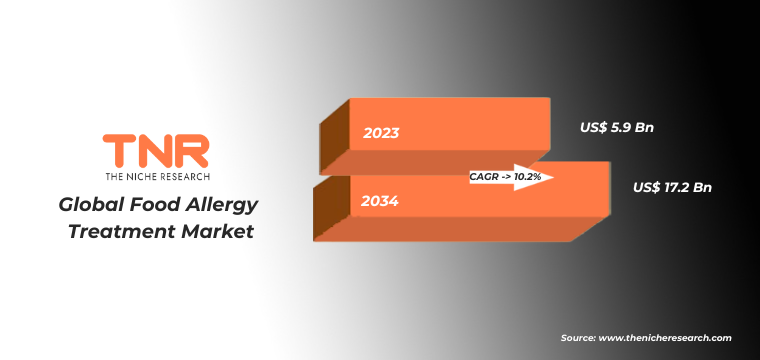
Global Food Allergy Treatment Market Dynamics
Rising Prevalence of Food Allergies: The global increase in food allergies, particularly among children, drives the demand for effective treatments. Factors such as changes in diet, environmental influences, and genetic predispositions contribute to this trend, leading to a larger patient population requiring medical interventions.
Advancements in Treatment Options: Innovations in immunotherapy, biologics, and diagnostic tools have expanded the arsenal of treatments available for food allergies. These advancements not only offer more effective management but also reduce the frequency and severity of allergic reactions, improving patient outcomes and driving market growth.
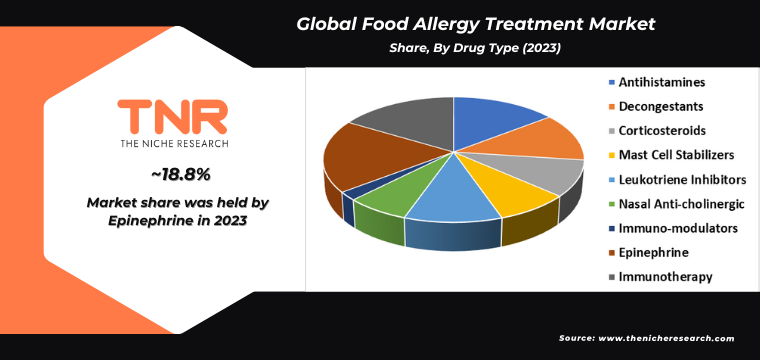
Increased Awareness and Diagnosis: Heightened awareness campaigns and better diagnostic techniques have led to more frequent identification of food allergies. Early and accurate diagnosis enables timely intervention, increasing the demand for allergy treatments and supportive care products, including epinephrine auto-injectors and specialized diets.
Regulatory Support and Guidelines: Government agencies and health organizations are implementing guidelines and policies to ensure the safety and availability of food allergy treatments. Regulatory support facilitates the development and approval of new therapies, fostering market expansion and encouraging pharmaceutical innovation.
Growing Investment in Research and Development: Significant investments by pharmaceutical companies and research institutions in developing novel treatments for food allergies are accelerating market growth. These investments are focused on creating more effective, long-lasting, and safer therapies, which are essential for meeting the increasing global demand.
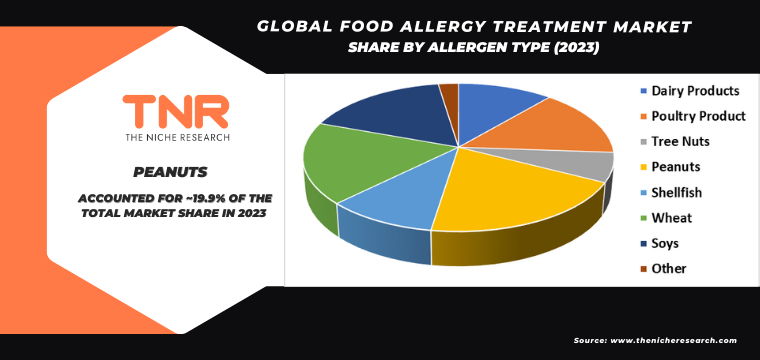
By Route of Administration Parental Segment had the Highest Share in the Global Food Allergy Treatment Market in 2023.
The demand for parenteral food allergy treatments is driven by the urgent need for rapid and effective intervention in severe allergic reactions, particularly anaphylaxis. Parenteral administration, which includes intravenous and intramuscular injections, offers the quickest route for delivering medications such as epinephrine, which is critical in halting the progression of life-threatening symptoms. This urgency is compounded by the increasing prevalence of food allergies and the heightened awareness among healthcare professionals and the general public about the risks associated with anaphylactic reactions.
Furthermore, advancements in biologic therapies that are administered parenterally have opened new avenues for managing chronic and acute food allergies, providing longer-lasting protection and reducing the frequency of reactions. Hospital emergency departments, urgent care centers, and specialized allergy clinics rely heavily on these treatments, ensuring that they are a fundamental component in emergency medical kits and protocols, thus driving the consistent demand for parenteral solutions.
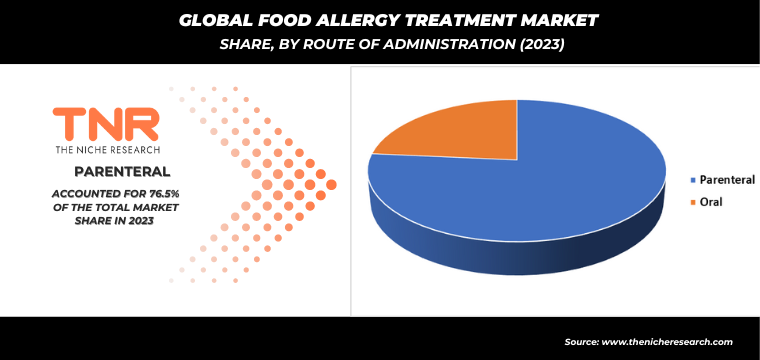
By End Use Hospital Pharmacies had the Highest Share in the Global Food Allergy Treatment Market in 2023.
The demand for food allergy treatments in hospital pharmacies is significantly driven by the increasing incidence of food allergies and the need for prompt, effective management of allergic reactions. As hospitals serve as critical points of care for severe and life-threatening allergic responses, there is a growing requirement for a reliable supply of epinephrine auto-injectors, antihistamines, and corticosteroids. Additionally, advancements in immunotherapy and the development of new biologic drugs necessitate their availability within hospital pharmacies to provide immediate and ongoing treatment options.
The integration of specialized allergy clinics within hospitals further amplifies this demand, as these clinics often rely on hospital pharmacies for the provision of diagnostic tools and treatment regimens. Moreover, heightened awareness and improved diagnostic techniques lead to earlier detection and treatment, reinforcing the role of hospital pharmacies in managing food allergies effectively. This comprehensive approach ensures patient safety and aligns with the growing emphasis on personalized medicine.
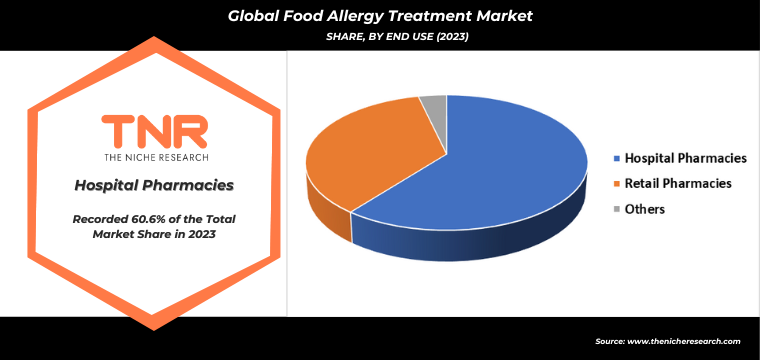
North America, by region had the Highest Share in Global Food Allergy Treatment Market in 2023.
In North America, the demand for food allergy treatment is driven by several factors, including the rising prevalence of food allergies, increased awareness and diagnosis, and the growing market for allergy-friendly foods. With more individuals, particularly children, being diagnosed with conditions like peanut, tree nut, and dairy allergies, there is a heightened need for effective treatments and management strategies. The healthcare sector is responding with innovative therapies, such as oral immunotherapy and biologics, designed to desensitize patients to allergens and reduce the risk of severe reactions.
Additionally, the proactive stance of parents, schools, and healthcare providers in advocating for better safety measures and education further propels the demand for specialized treatments. This trend is also fueled by advancements in medical research, which continuously seek to improve the quality of life for those affected by food allergies.

Competitive Landscape: Global Food Allergy Treatment Market:
- Aimmune Therapeutics (Nestle SA)
- Alladapt Immunotherapeutics, Inc.
- Aravax
- COUR Pharmaceuticals
- DBV Technologies
- Prota Therapeutics
- Sanofi
- Teva Pharmaceuticals
- Vedanta Biosciences, Inc.
- Other Industry Participants
Global Food Allergy Treatment Market Scope
| Report Specifications | Details |
| Market Revenue in 2023 | US$ 5.9 Bn |
| Market Size Forecast by 2034 | US$ 17.2 Bn |
| Growth Rate (CAGR) | 10.2% |
| Historic Data | 2016 – 2022 |
| Base Year for Estimation | 2023 |
| Forecast Period | 2024 – 2034 |
| Report Inclusions | Market Size & Estimates, Market Dynamics, Competitive Scenario, Trends, Growth Factors, Market Determinants, Key Investment Segmentation, Product/Service/Solutions Benchmarking |
| Segments Covered | By Allergen Type, By Drug Type, By Route of Administration, By End Use, By Region |
| Regions Covered | North America, Europe, Asia Pacific, Middle East & Africa, Latin America |
| Countries Covered | U.S., Canada, Mexico, Rest of North America, France, The UK, Spain, Germany, Italy, Nordic Countries (Denmark, Finland, Iceland, Sweden, Norway), Benelux Union (Belgium, The Netherlands, Luxembourg), Rest of Europe, China, Japan, India, New Zealand, Australia, South Korea, Southeast Asia (Indonesia, Thailand, Malaysia, Singapore, Rest of Southeast Asia), Rest of Asia Pacific, Saudi Arabia, UAE, Egypt, Kuwait, South Africa, Rest of Middle East & Africa, Brazil, Argentina, Rest of Latin America |
| Key Players | Aimmune Therapeutics (Nestle SA), Alladapt Immunotherapeutics, Inc., Aravax, COUR Pharmaceuticals, DBV Technologies, Prota Therapeutics, Sanofi, Teva Pharmaceuticals, Vedanta Biosciences, Inc. |
| Customization Scope | Customization allows for the inclusion/modification of content pertaining to geographical regions, countries, and specific market segments. |
| Pricing & Procurement Options | Explore purchase options tailored to your specific research requirements |
| Contact Details | Consult With Our Expert
Japan (Toll-Free): +81 663-386-8111 South Korea (Toll-Free): +82-808- 703-126 Saudi Arabia (Toll-Free): +966 800-850-1643 United Kingdom: +44 753-710-5080 United States: +1 302-232-5106 E-mail: askanexpert@thenicheresearch.com
|
Global Food Allergy Treatment Market
By Allergen Type
- Dairy Products
- Poultry Product
- Tree Nuts
- Peanuts
- Shellfish
- Wheat
- Soys
- Other
By Drug Type
- Antihistamines
- Decongestants
- Corticosteroids
- Mast Cell Stabilizers
- Leukotriene Inhibitors
- Nasal Anti-cholinergic
- Immuno-modulators
- Epinephrine
- Immunotherapy
- Xolair
- PALFORZIA
- Others
By Route of Administration
- Parenteral
- Oral
By End Use
- Hospital Pharmacies
- Retail Pharmacies
- Others
By Region
- North America (U.S., Canada, Mexico, Rest of North America)
- Europe (France, The UK, Spain, Germany, Italy, Nordic Countries (Denmark, Finland, Iceland, Sweden, Norway), Benelux Union (Belgium, The Netherlands, Luxembourg), Rest of Europe)
- Asia Pacific (China, Japan, India, New Zealand, Australia, South Korea, Southeast Asia (Indonesia, Thailand, Malaysia, Singapore, Rest of Southeast Asia), Rest of Asia Pacific)
- Middle East & Africa (Saudi Arabia, UAE, Egypt, Kuwait, South Africa, Rest of Middle East & Africa)
- Latin America (Brazil, Argentina, Rest of Latin America)
Report Layout:
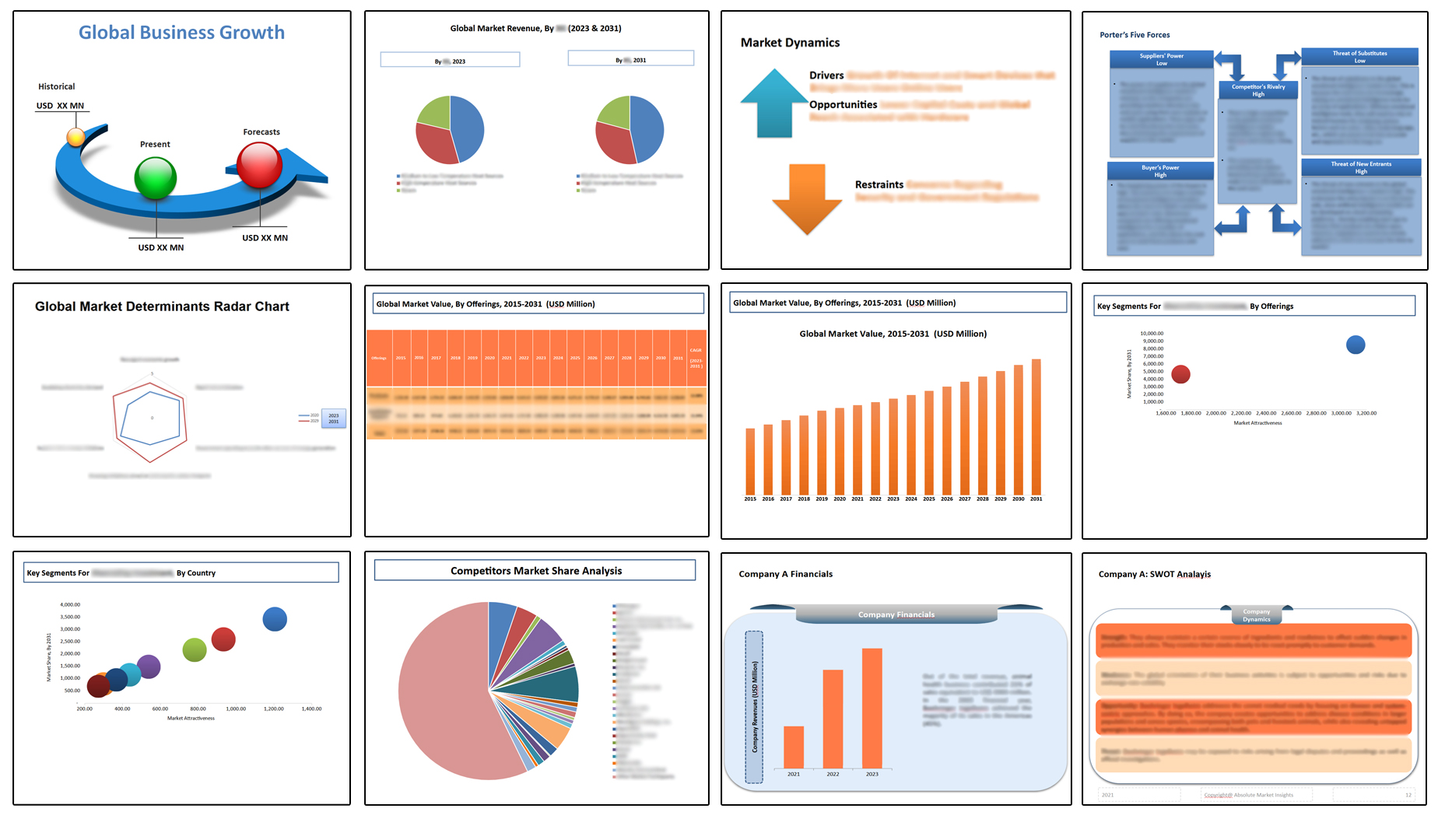
Table of Contents
Note: This ToC is tentative and can be changed according to the research study conducted during the course of report completion.
**Exclusive for Multi-User and Enterprise User.
Global Food Allergy Treatment Market
By Allergen Type
- Dairy Products
- Poultry Product
- Tree Nuts
- Peanuts
- Shellfish
- Wheat
- Soys
- Other
By Drug Type
- Antihistamines
- Decongestants
- Corticosteroids
- Mast Cell Stabilizers
- Leukotriene Inhibitors
- Nasal Anti-cholinergic
- Immuno-modulators
- Epinephrine
- Immunotherapy
- Xolair
- PALFORZIA
- Others
By Route of Administration
- Parenteral
- Oral
By End Use
- Hospital Pharmacies
- Retail Pharmacies
- Others
By Region
- North America (U.S., Canada, Mexico, Rest of North America)
- Europe (France, The UK, Spain, Germany, Italy, Nordic Countries (Denmark, Finland, Iceland, Sweden, Norway), Benelux Union (Belgium, The Netherlands, Luxembourg), Rest of Europe)
- Asia Pacific (China, Japan, India, New Zealand, Australia, South Korea, Southeast Asia (Indonesia, Thailand, Malaysia, Singapore, Rest of Southeast Asia), Rest of Asia Pacific)
- Middle East & Africa (Saudi Arabia, UAE, Egypt, Kuwait, South Africa, Rest of Middle East & Africa)
- Latin America (Brazil, Argentina, Rest of Latin America)
The Niche Research approach encompasses both primary and secondary research methods to provide comprehensive insights. While primary research is the cornerstone of our studies, we also incorporate secondary research sources such as company annual reports, premium industry databases, press releases, industry journals, and white papers.
Within our primary research, we actively engage with various industry stakeholders, conducting paid interviews and surveys. Our meticulous analysis extends to every market participant in major countries, allowing us to thoroughly examine their portfolios, calculate market shares, and segment revenues.
Our data collection primarily focuses on individual countries within our research scope, enabling us to estimate regional market sizes. Typically, we employ a bottom-up approach, meticulously tracking trends in different countries. We analyze growth drivers, constraints, technological innovations, and opportunities for each country, ultimately arriving at regional figures.Our process begins by examining the growth prospects of each country. Building upon these insights, we project growth and trends for the entire region. Finally, we utilize our proprietary model to refine estimations and forecasts.
Our data validation standards are integral to ensuring the reliability and accuracy of our research findings. Here’s a breakdown of our data validation processes and the stakeholders we engage with during our primary research:
- Supply Side Analysis: We initiate a supply side analysis by directly contacting market participants, through telephonic interviews and questionnaires containing both open-ended and close-ended questions. We gather information on their portfolios, segment revenues, developments, and growth strategies.
- Demand Side Analysis: To gain insights into adoption trends and consumer preferences, we reach out to target customers and users (non-vendors). This information forms a vital part of the qualitative analysis section of our reports, covering market dynamics, adoption trends, consumer behavior, spending patterns, and other related aspects.
- Consultant Insights: We tap into the expertise of our partner consultants from around the world to obtain their unique viewpoints and perspectives. Their insights contribute to a well-rounded understanding of the markets under investigation.
- In-House Validation: To ensure data accuracy and reliability, we conduct cross-validation of data points and information through our in-house team of consultants and utilize advanced data modeling tools for thorough verification.
The forecasts we provide are based on a comprehensive assessment of various factors, including:
- Market Trends and Past Performance (Last Five Years): We accurately analyze market trends and performance data from preceding five years to identify historical patterns and understand the market’s evolution.
- Historical Performance and Growth of Market Participants: We assess the historical performance and growth trajectories of key market participants. This analysis provides insights into the competitive landscape and individual company strategies.
- Market Determinants Impact Analysis (Next Eight Years): We conduct a rigorous analysis of the factors that are projected to influence the market over the next eight years. This includes assessing both internal and external determinants that can shape market dynamics.
- Drivers and Challenges for the Forecast Period:Identify the factors expected to drive market growth during the forecast period, as well as the challenges that the industry may face. This analysis aids in deriving an accurate growth rate projection.
- New Acquisitions, Collaborations, or Partnerships: We keep a close watch on any new acquisitions, collaborations, or partnerships within the industry. These developments can have a significant impact on market dynamics and competitiveness.
- Macro and Micro Factors Analysis:A thorough examination of both macro-level factors (e.g., economic trends, regulatory changes) and micro-level factors (e.g., technological advancements, consumer preferences) that may influence the market during the forecast period.
- End-User Sentiment Analysis: To understand the market from the end-user perspective, we conduct sentiment analysis. This involves assessing the sentiment, preferences, and feedback of the end-users, which can provide valuable insights into market trends.
- Perspective of Primary Participants: Insights gathered directly from primary research participants play a crucial role in shaping our forecasts. Their perspectives and experiences provide valuable qualitative data.
- Year-on-Year Growth Trend: We utilize a year-on-year growth trend based on historical market growth and expected future trends. This helps in formulating our growth projections, aligning them with the market’s historical performance.
Research process adopted by TNR involves multiple stages, including data collection, validation, quality checks, and presentation. It’s crucial that the data and information we provide add value to your existing market understanding and expertise. We have also established partnerships with business consulting, research, and survey organizations across regions and globally to collaborate on regional analysis and data validation, ensuring the highest level of accuracy and reliability in our reports.









